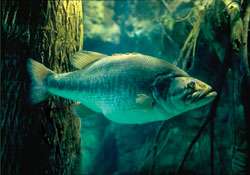
To catch that biggest bass of your lifetime, you need to know where the mammoths hang out. The solution is to learn to recognize their lairs and invade them with the proper lures. Let ol' Unc share with you 10 proven hangouts for lunkers, and the tactics that do the catching.Commit each lair to memory, and keep them in mind on your next fishing trip. Once you learn the combination of lures and tactics for penetrating them, you could catch more big bass in one season than most bassin' men catch in a lifetime.Smart tactic — take along a pad and make salient notes, such as: type of hangout and the position of your boat during the catching, date, time of day, weather, payoff lures and special ways you worked them. Thus fortified, when you take off the next year, you'll do so with full confidence that you are going to tangle with whopper bass …and you will.
And if you have a GPS display that enables you to return to the same spot, super. If not, don't fret — get a topographical map from your county engineer to show lake depths and bottom features.
Ready for the 10 big bass home sites? As you stroll through each one, try to think of waters you fish that have these same features. And do you have these lures in your tacklebox?
1. SHORE BRUSH, BUSHES. These dense covers are ideal seclusions for small aquatic critters on which shad and minnows feed. Big bass know this and stalk these spots whenever the hunger urge motivates them.
Here is one place where accurate casting pays off, because bigger bass have no need to chase lures too far for a quick strike. So, choose lures that are rigged weedless so you can drop them in the midst of snaggy cover. Work them slowly, from top to bottom.
2. STUMPS, STANDING TIMBER. Big bass hide in the shadows of these covers, ready to ambush passing prey. In calm water, work minnow-like surface lures slowly, with intermittent fast twitches, like they're scared and trying to escape. Also, try buzzbaits and chugger types. And be sure to tempt them with Texas rigged 12-inch monster worms — a hefty meal in one gulp.
3. OLD CREEK CHANNELS, ROAD BEDS. You'll see where old roads disappear into a lake, and a topo map will reveal creek channels. Fish bottom-nudging lures, deep running crankbaits, overhead spinners and weedless worms. A leadhead jig with a crawfish body crawled over the bottom is deadly.
4. STICKUPS. A native term for weed tips, tops of submerged brush or remains of dead trees — anything that stands out above the water's surface. Cast a plastic worm beyond the stickup and let it settle to the bottom, counting it down … perhaps 10 counts. Then, retrieve it at lesser counts to cover all levels and the perimeter of the stickup.
5. WINDY SHORES. It's not fun to fight the wind, but breezes blow insects and algae into the lake, and small fish come to feed — and big bass come to feed on them. Use lures that resemble small fish — those with enough weight to cast against a breeze — like small, heavy spoons, weighted tailspinners, 1/2-ounce jigheads with grubs and blade lures. Keep moving and offer a variety of lures, staying with color patterns like shiner, shad and bluegill. Work them slowly, speedily and in spurts.
6. OUTSIDE CREEK BENDS. Where the current flows, the food goes, and the bass knows. Where current breaks off a point and heads for a bank, notice the outside bend. The current is strong and will undercut the bank. These undercuts offer shade and rest from outer current pressure. They are also ambush spots to nab passing morsels. Use big-lipped crankbaits that current will drive deep and close to the undercuts. Retrieve both slowly and quickly.
7. BELOW DAMS. Look for the payoff spot called "the slot." It's a detectable line formed between fast moving downstream current and the eddy water that flows slowly back toward the dam. Retrieve deep running lures, such as slab spoons, big-lipped crankbaits, heavy spinner lures and blade baits, outside the slot.
8. LILY PAD CONCENTRATIONS. Ideal hangouts for big bass to lurk are in the shade provided by leaf masses. Give them a smorgasbord of lures: chuggers and spinners on top; crankbaits retrieved on the outer perimeters; weedless spoons and Texas rigged worms crawled over the weedy roof. Also, a giant 12-inch floating worm with a big curly tail, reeled slowly through every slot and over pads into dark holes.
9. ROCKY SHORELINES. These can be riprap, gravel, stones — any hard surface that disappears into deep water. Big bass grub the bottom looking for hiding crawfish, snails and leeches. One potent lure is a soft crawfish body rigged weedless on a heavy jighead. Cast it into shallow water and work it slowly downgrade, like a crawfish scrounging the bottom in search of food morsels. Another is a soft plastic minnow body cast toward shore and worked down the rocky slopes with terse, fast rod-tip twitches.
10. SHOALS AND REEFS. These are varied, submerged bottom structures, either circular or elongated, situated in water from a few feet deep to 25- to 50-foot depths. It takes some probing to locate the deeper ones.
One way to learn their contours is to troll deep running lures that keep contacting bottom as you move along. Once you learn these outlines and depths, record them in that notebook. Cast across and parallel with bottom-contacting lures such as jigs and spoons.So, there are the Top 10 big bass hangouts waiting to be tapped. Well, what's holding you up?
